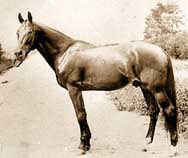Standardbred
N/A
Mon, 25th November, 2024 - 12:31 pm GMT
Sponsor Ads:

Alternative Name
N/ABasic Info
In many respects, the Standardbred resembles its ancestor the Thoroughbred. It does not stand as tall, averaging 15.2 hands, although it has a longer body. The head is refined, set on a medium-sized neck. The quarters are muscular yet sleek. The clean hind legs are set well back. Individual Standardbreds tend to either trot or pace. This breed appears in varying colors, although bay, brown and black are predominant. It weighs between 800 and 1000 pounds. Gaits Standardbred racing is contested on two gaits, the trot and the pace. Trotters move with a diagonal gait; the left front and right rear legs move in unison, as to the right front and left rear. It requires much skill by the trainer to get a trotter to move perfectly at high speeds, even though the trotting gait is a natural one in the animal world. But horseman and fans agree that there are few things more beautiful than a trotting horse in full stride. Pacers, on the other hand, move the legs on one side of their body in tandem: left front and rear, and right front and rear. This action shows why pacers are often called "sidewheelers." Pacers, which account for about 80 percent of the performers in harness racing, are aided in maintaining their gait by plastic loops called hobbles, which keep their legs moving in synchronization. Due to the sureness of their action, pacers are usually several seconds faster than trotters. Actually, a third gait often manifests itself in harness racing running. But a horse who runs, or goes "off-stride" in the parlance of the sport, must return to his natural gait or face disqualification.
Health
N/AHabitat
N/ABehavior
Use : Racing, driving. Fastest trotter in the world. Bred for speed, not looks.Origin
The origins of the Standardbred trace back to Messenger, an English Thoroughbred foaled in 1780, and later exported to the United States. Messenger was the great-grandsire of Hambletonian 10, to whom every Standardbred can trace its heritage. Thus, StandaHistory
The first Standardbred races were contested along roads, with men challenging their friends to see who had the swifter steed. Often the streets of major cities were cleared and races conducted. That's why so many American cities have a Race Street. Over the years, sportsmen came to recite the names of certain champions with awe: Flora Temple, the "Bob-Tailed Nag" of Stephen Foster's Camptown Races; Goldsmith Maid, who won 350 heats in her storied career; world champions Maud S. and Nancy Hanks. They were all trotters but pacers soon began to gain acceptance with the sport's first two-minute mile, recorded in 1897 by the pacer Star Pointer. The horse who popularized pacing was Dan Patch, one of the fastest (1:55 for the mile) and most popular Standardbreds ever. Harness racing continued to flourish until World War I, after which the sport suffered two lean decades. But world records by pacer Billy Direct and trotter Greyhound in 1938 signaled a rebirth, and the sport began to move forward in 1940 when a group of businessmen took the heretofore rural sport and set it in the bright lights of New York City as a pari-mutuel activity. It was years before the new track, Roosevelt Raceway, on Long Island made money, but the night time "sulkies" soon caught on in many metropolitan areas, and today harness racing is firmly established as one of the biggest of big-league sports. The past few years have seen major improvements in racetrack construction and maintenance; in sulky and harness design; and in the breed itself. The legendary Niatross heralded a new era with a 1:49-1/5 time-trial, the first harness horse to break 1:50.Common Foods
grassSponsor Ads:
"If fighting is sure to result in victory, then you must fight, even though the ruler forbid it; if fighting will not result in victory, then you must not fight even at the ruler's bidding." -- Sun Tzu, The Art of War
Standardbred
Coded by: BGID® | ALL RIGHTS RESERVED Copyright © 2000-2024
Disclaimer | Privacy | Report Errors / Contact | Credits








 Homosexual behavior stems from the mind or genetics?
Homosexual behavior stems from the mind or genetics?  The Best Text Adventure You Will Ever Play! The official site:
The Best Text Adventure You Will Ever Play! The official site:  Why haven't we as a collective earth met with aliens yet?
Why haven't we as a collective earth met with aliens yet?  World EcoSystem - Biodiversity Changes - Who is on board and who isn
World EcoSystem - Biodiversity Changes - Who is on board and who isn  Mouthwash - Mouthrinse - Mouth Sores - Healing Infections - Gingivitis
Mouthwash - Mouthrinse - Mouth Sores - Healing Infections - Gingivitis  Treatment for Depression
Treatment for Depression  Ultra radical and violent Islamist group that even rivals Al Qaeda
Ultra radical and violent Islamist group that even rivals Al Qaeda  An idea to have teachers who want to carry guns to school undergo some level of police training will be left up to local school districts and police departments.
An idea to have teachers who want to carry guns to school undergo some level of police training will be left up to local school districts and police departments.